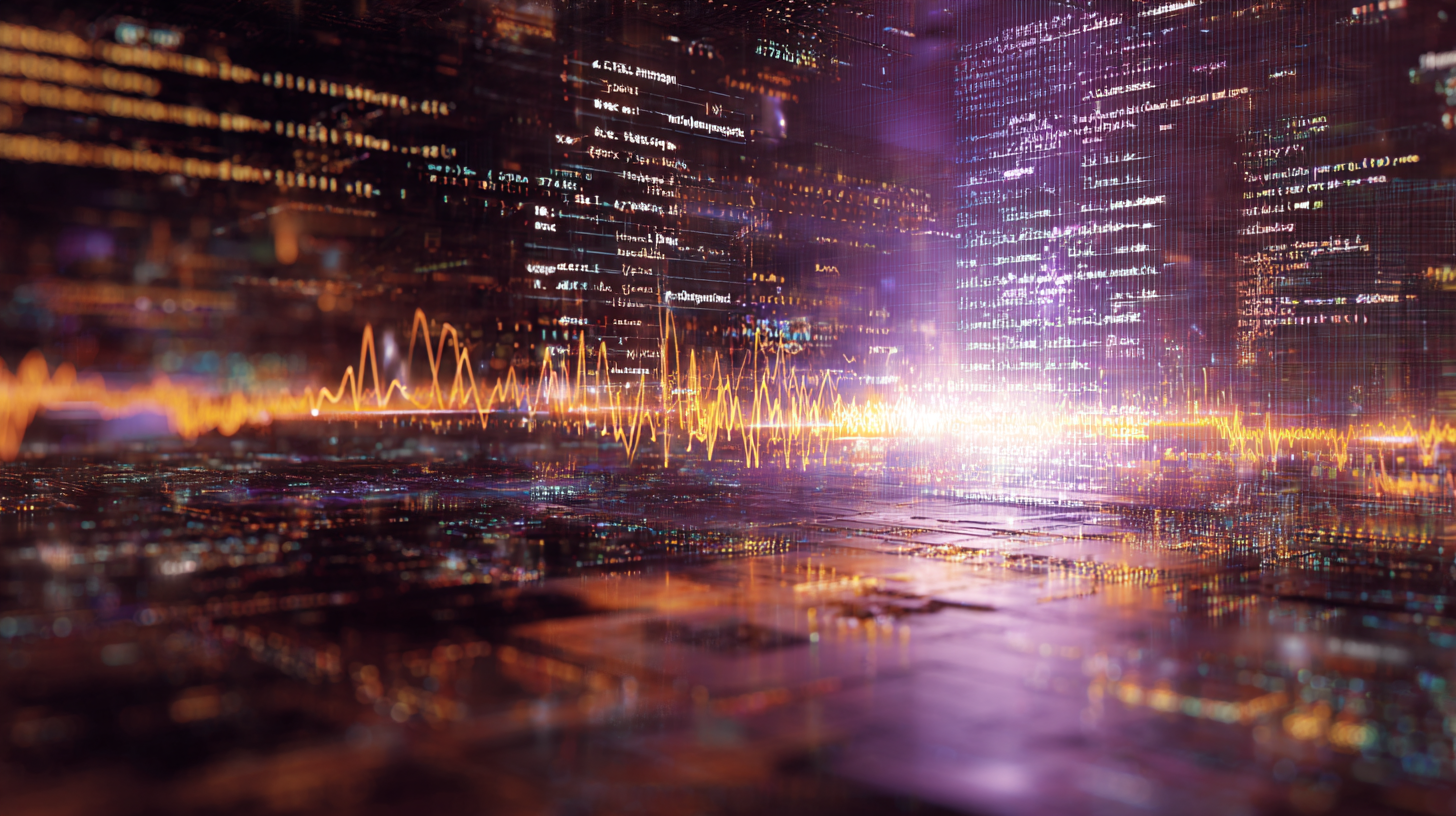By 2038, AI Agents Unlock The Global Age Of Autonomous Action #Trend
Uncover the Technology trend: AI Agents unlock the global age of autonomous action by 2038. This article details how proactive AI transforms industries and life. Learn about this pivotal shift.

By 2038, the very fabric of our digital and physical world will be fundamentally redefined, not just by smarter tools, but by AI Agents taking intelligent, autonomous action on a global scale. This isn't a future we're passively approaching; it's one being actively architected right now, heralding the true age of autonomous operation. 🤔
We stand at the threshold of an era where AI moves beyond response into proactive, goal-driven execution; unlocking the immense potential hinted at in the of this article. It's a seismic shift that, through our unique Autonomy Spectrum lens, signals a critical leap in machine capability and a profound redefinition of human-technology interaction. The implications are vast, exciting, and demand immediate foresight. 💡 #AgenticFuture #AutonomousAI
But how did we arrive at this pivotal moment, and what exactly does this trajectory towards intelligent autonomy entail? Join us as we dissect the journey of AI Agents; from their foundational algorithmic ancestry to their dynamic capabilities in the present, and chart their electrifying path forward into the global age of autonomous action. 🧭
Ready to grasp the forces poised to reshape work, society, and perhaps your own daily life at its core? Let’s explore the past, present, and visionary future of AI Agents. 🚀 #TrendHorizon
I. Demystifying AI Agents: The Architecture of Autonomous Action 🧠 #TrendExplained
At Trend Horizon, we observe the rapid emergence of AI Agents, often referred to as 'Autonomous Agents', as a pivotal development transforming the landscape of Artificial Intelligence. These are not merely sophisticated software programs; they are advanced systems meticulously engineered to leverage AI for perceiving their operational environment, making intelligent decisions, and executing autonomous actions to achieve specific goals or complete complex tasks on behalf of users.
As Franklin and Graesser articulated in their seminal 1997 definition, an Autonomous Agent is "a system situated within and a part of an environment that senses that environment and acts on it, over time, in pursuit of its own agenda and so as to effect what it senses in the future".
This aptly captures the proactive, persistent, and goal-driven essence that truly distinguishes these digital entities.
Distinguishing AI Agents: A Spectrum of Autonomy
To fully appreciate the significance of AI Agents, it is crucial to differentiate them from their less autonomous counterparts. At Trend Horizon, we utilize a comparative framework positioning them on an "Autonomy Spectrum" relative to AI Assistants and traditional Bots. This spectrum is crucial for understanding the qualitative leap AI Agents represent.
- Bots: Occupying the lower end, bots typically automate simple, repetitive tasks or engage in basic conversations based on predefined rules and scripts. Their capacity for learning is generally limited, reacting to specific triggers or commands rather than demonstrating independent initiative.
- AI Assistants (e.g., Siri, Alexa): These systems are designed primarily to assist users by responding to direct requests, providing information, and completing relatively simple, circumscribed tasks. While they might recommend actions, the ultimate decision-making authority rests with the human user. Their interaction style is predominantly reactive, awaiting user prompts.
- AI Agents: Residing at the highest tier, the primary purpose of AI agents is to autonomously and proactively undertake complex, often multi-step, tasks. They are endowed with the capabilities for independent decision-making, continuous learning, and dynamic adaptation to new information or changing circumstances. Their mode of interaction is characteristically proactive and oriented towards achieving predefined goals. They are not just doing things for us, but increasingly, thinking and acting with us, and sometimes, ahead of us.
This technological trajectory towards increasing levels of autonomy is a core element of the AI Agent trend, driven primarily by breakthroughs in foundational AI models. Understanding this spectrum is vital for businesses to strategically deploy the right AI tools and for society to anticipate the varying implications of different AI systems.
| Feature | Bots | AI Assistants (e.g., Siri, Alexa) | AI Agents |
|---|---|---|---|
| Purpose | Automate simple tasks/conversations | Assist users with tasks, provide info | Autonomously & proactively perform complex tasks to achieve goals |
| Core Capabilities | Follow pre-defined rules | Respond to requests, complete simple tasks | Reason, plan, learn, adapt, make decisions independently, use tools |
| Interaction Style | Reactive; responds to triggers/commands | Reactive; responds to user requests | Proactive; goal-oriented; can initiate actions |
| Level of Autonomy | Low; follows programmed rules | Medium; requires user input for decisions | High; operates and makes decisions independently |
| Task Complexity Handling | Simple, repetitive tasks | Simple to moderately complex tasks | Complex, multi-step actions and workflows |
| Learning & Adaptation | Limited or no learning | Some learning capabilities | Learns from experience, adapts to new situations, improves over time |
| Typical Examples | Simple customer service chatbots, data entry bots | Siri, Alexa, Google Assistant | Autonomous research agents, advanced process automation systems, robotic process automation with decision-making |
The Agent's DNA: Fundamental Characteristics
Several fundamental characteristics, or what we might call an AI Agent's DNA, define their advanced functionality and underpin their capacity for self-governance:
- Autonomy: This is the cornerstone. It refers to the capacity of an AI Agent to operate and make decisions independently, with minimal or no human intervention after initial deployment, in pursuit of its designated goals.
- Goal-Orientation & Proactiveness: Unlike purely reactive systems, AI Agents are engineered to pursue specific, often complex, goals. They can proactively initiate actions and sequences of operations to achieve these objectives.
- Adaptability & Learning: A key strength is their ability to learn from experience and interaction. They can adapt their behavior and strategies in response to changing environmental conditions, new data, or the outcomes of their previous actions, often employing sophisticated machine learning algorithms.
- Reasoning & Planning: AI Agents exhibit the capability to reason about perceived information, analyze complex situations, and plan sequences of actions. This involves breaking down high-level goals into manageable sub-tasks and strategizing effective paths.
- Perception & Interaction: AI Agents perceive their operational environment through various input modalities (sensors, data feeds, APIs, user interfaces) and can interact with it, including engaging in natural language communication.
- Task-Specificity (Evolving): While contemporary AI Agents are often designed for narrow tasks, the clear trend is towards expanding their versatility to handle a broader range of more generalized tasks.
The Cognitive Engine: Advanced AI Models at the Helm
The remarkable capabilities of modern AI Agents are directly fueled by breakthroughs in the underlying AI models that form their "cognitive engine". Large Language Models (LLMs), such as OpenAI's ChatGPT, Google's Gemini, and Anthropic's Claude, often serve as the central "brain", providing core reasoning, language understanding, and decision-making abilities. Pre-trained on vast datasets, LLMs excel at interpreting user goals, analyzing problems, devising plans, and generating not only text but also potential code or internal "thoughts" to guide behavior. This allows for rapid deployment and adaptability, a significant leap from pre-LLM agents that relied on more rigid, scripted behaviors. #LLMpower
Extending beyond text, Large Multimodal Models (LMMs) represent the next frontier, engineered to process and integrate information from multiple data modalities simultaneously; including text, images, audio, and video. LMMs empower AI Agents to effectively "see" and "hear," enabling a more holistic, human-like comprehension of their environment. This is critical for AI Agents designed for complex real-world interactions or tasks involving non-textual data. With Gartner forecasting a significant rise in multimodal AI adoption, from 1% in 2023 to an anticipated 40% by 2027, LMMs are set to dramatically expand the operational envelope and problem-solving prowess of AI Agents, paving the way for even more sophisticated and contextually aware autonomous systems.
The Core Mandate: Purpose-Driven Intelligence
The fundamental purpose driving the development of AI Agents is the creation of intelligent systems that can autonomously and proactively pursue designated goals and execute complex, often multi-step, tasks on behalf of users (or other systems). This pursuit aims to unlock new levels of efficiency, enhance productivity, and augment human capabilities.
At Trend Horizon, we see this not as mere task automation, but as the cultivation of intelligent partners capable of independent reasoning, strategic planning, and dynamic adaptation. Their overarching significance lies in the trajectory towards increasingly autonomous and intelligent systems, designed to tackle tasks of ever-increasing complexity and scope, fundamentally altering how challenges are approached and value is created. #PurposeDrivenAI #AugmentedHumanity

II. Unearthing AI Agents: A Journey Through Their Algorithmic Ancestry 📜🤖🧬 #TrendHistory
The quest for AI Agents is not a recent phenomenon born from the latest technological buzz; its origins are deeply woven into the fabric of Artificial Intelligence history. We can trace the earliest conceptual whispers back to the mid-20th century, a time of bold dreams about "thinking machines". Visionaries like Alan Turing, with his 1950 paper proposing the Turing Test as an operational framework for assessing machine intelligence, initiated the journey by fundamentally asking if a machine could exhibit intelligent behavior indistinguishable from that of a human. This was soon followed by the landmark 1956 Dartmouth Summer Research Project, an event that officially coined the term "Artificial Intelligence" and galvanized the field, setting the stage for decades of dedicated research. #AIHistory #EarlyAI
In these nascent years, pioneers like Allen Newell and Herbert Simon focused on creating programs that could solve well-defined, logical problems. Their 1956 Logic Theorist, considered the first program designed to mimic human problem-solving capabilities by proving mathematical theorems, and their subsequent 1959 General Problem Solver, were crucial first steps. These systems operated predominantly on the principles of Symbolic AI. The early AI landscape also saw a methodological divergence between Symbolic AI, focusing on explicit knowledge representation, and Statistical AI, emphasizing probability and pattern recognitio; a precursor to modern machine learning. The 1960s and 70s saw the emergence of rudimentary rule-based systems. Think of early chatbots like Joseph Weizenbaum's 1964 ELIZA, which could simulate conversation by matching patterns. Then came Expert Systems like MYCIN (for medical diagnoses) and DENDRAL (for chemical analysis) in the 70s and 80s, operating on "if-then" logic within narrow domains. However, these systems were rigid, unable to learn from new experiences. A significant conceptual advancement during this period was the Belief-Desire-Intention model, providing a powerful framework for designing AI Agents with explicit mental states (beliefs, desires/goals, intentions), a crucial step towards more autonomous thinking. #ExpertSystems #BDImodel
Learning to Act and Cooperate
The limitations of purely rule-based systems highlighted a critical need: learning. The 1980s and 90s saw a significant shift towards Machine Learning and the resurgence of Connectionism (neural networks), emphasizing enabling systems to learn patterns and behaviors directly from data. Pioneering projects like Carnegie Mellon University's 1986 Navlab 1, an early autonomous vehicle, showcased the potential of AI learning to navigate the real world. Simultaneously, the field of Multi-Agent Systems (MAS) blossomed, evolving from Distributed Artificial Intelligence (DAI). MAS research focused on understanding how multiple Autonomous Agents could coordinate, collaborate, negotiate, or even compete effectively. This was vital groundwork for the sophisticated AI teams we're starting to see. And who could forget IBM's Deep Blue defeating chess champion Garry Kasparov in 1997? A major moment showing AI could strategize at superhuman levels in complex games. ♟️
The 2010s truly supercharged the journey with the Deep Learning revolution, fueled by massive datasets, powerful GPUs, and algorithmic breakthroughs in neural network architectures. Suddenly, AI achieved remarkable success in areas like image recognition and understanding human language. This led to smarter virtual assistants like Apple's (2011) Siri, Google Assistant, and Microsoft's Cortana. While impressive, these were mostly reactive. DeepMind's AlphaGo defeating a Go world champion in 2016, using Deep Reinforcement Learning (DRL), was another stunning demonstration of AI's learning prowess. These advancements provided the foundational capabilities for the subsequent emergence of truly autonomous AI Agents.
Key Milestones and Technological Enablers Leading to Current AI Agents
The transition to current AI Agents required integrating several key technological enablers. Advanced Prompt Engineering emerged as crucial for guiding LLMs. Reinforcement Learning from Human Feedback (RLHF) proved instrumental in aligning LLM behavior with human preferences, making them safer and more reliable. Retrieval-Augmented Generation (RAG) addressed knowledge cutoffs by enabling LLMs to access external, up-to-date information. Perhaps most transformative was Tool Integration / Function Calling, allowing LLMs to interact with external tools (APIs, databases, code interpreters), transforming them from passive processors into active Agents capable of tangible actions. Underlying all this were continuous Hardware Advancements, providing the necessary computational power.
The period following late 2022, particularly with the public release of OpenAI's ChatGPT, marked a distinct inflection point. This catalyzed a massive acceleration in AI adoption and a shift from standalone LLMs to embedding them within more autonomous, task-oriented frameworks. Early experimental open-source projects like Auto-GPT and BabyAGI in early 2023 vividly demonstrated these nascent "Agentic" AI systems, showcasing how LLMs could be orchestrated to autonomously set goals, break them down, and attempt iterative completion, kicking off the historical chapter we're just beginning to write. This post-ChatGPT era represents a significant democratization and popularization wave, driven by accessible powerful LLMs and the rapid emergence of open-source agent frameworks, shifting AI development from a few large labs to a more distributed ecosystem. 🚀 #DeepLearning #LLMCatalyst
| Era/Period | Key Developments/Concepts | Significant Systems/Events | Impact on Agent Evolution |
|---|---|---|---|
| 1950s-1970s | Turing Test, Symbolic AI, Early Problem Solvers, Rule-Based Systems, First Chatbots | Logic Theorist, General Problem Solver (GPS), ELIZA | Laid conceptual foundations for "thinking machines" and rule-based decision-making. |
| 1970s-1980s | Expert Systems, Belief-Desire-Intention (BDI) Model, Emergence of Distributed AI (DAI) | MYCIN, DENDRAL, Procedural Reasoning System (PRS) | Captured domain-specific human expertise; BDI provided a mental model for autonomous agents; DAI explored distributed problem-solving. |
| 1980s-2000s | Resurgence of Machine Learning & Connectionism, Early Autonomous Vehicles, Multi-Agent Systems (MAS) Research, Deep Blue vs Kasparov (1997) | Navlab 1, Development of MAS frameworks, IBM Deep Blue | Shift towards systems that learn from data; demonstrated real-world autonomous navigation; MAS established principles for agent interaction; AI surpassed human intellect in complex games. |
| 2000s-Early 2010s | Advances in NLP, Rise of Intelligent Assistants | Siri (2008/2011), Google Now | Improved human-computer interaction through voice and language. |
| Mid 2010s-Early 2020s | Deep Learning Revolution (CNNs, RNNs, Transformers), Reinforcement Learning Advances, Improved NLP | AlphaGo, Advanced intelligent assistants (Cortana) | Breakthroughs in perception, language understanding, and learning complex strategies, providing powerful components for future agents. |
| Late 2022-Present | Generative AI (LLMs/LMMs) as Catalyst, Prompt Engineering, RLHF, RAG, Tool Integration, Emergence of "Agentic AI" | ChatGPT, GPT-4, Claude, Auto-GPT, BabyAGI, LangChain | LLMs provide cognitive core; RAG & Tool Use enable real-world interaction & grounding; rapid popularization and democratization of agent development. |

III. AI Agents Today: From Blueprints to Dynamic Actors in the Digital Arena ⚙️ #TrendInMotion
As we at Trend Horizon survey the landscape today, AI Agents are unequivocally shifting from theoretical constructs to practical, impactful entities. Fueled significantly by breakthroughs in Large Language Models (LLMs) and Large Multimodal Models (LMMs), these Agents are demonstrating increasingly sophisticated behaviors, carving out niches in diverse real-world applications, and cultivating a vibrant ecosystem of development. This isn't merely about enhanced automation; it's about the emergence of systems capable of complex, autonomous operations, learning, and interaction. However, our analysis reveals this rapid ascent is paralleled by a growing, critical awareness of the inherent complexities and limitations that define their current operational reality. #AIagentsNow #TechPresent
Advanced Capabilities in Action
Contemporary AI Agents are defined by a suite of sophisticated capabilities that collectively enable their autonomy, adaptability, and effectiveness. These are actively being implemented, refined, and deployed.
- Reflection: Learning and Self-Correction. A hallmark of advanced intelligence, reflection is the Agent's ability to critically review its own decisions, outputs, and actions, evaluate performance, identify weaknesses, and refine strategies; analogous to human metacognition. This often involves self-critique prompts, explicit justification of decisions, memory integration for learning from past feedback, and iterative feedback loops where outputs are re-evaluated and approaches modified. This leads to error reduction, optimized output quality, and improved decision-making over time, crucial for moving beyond pre-programmed responses towards genuinely intelligent behavior.
- Tool Usage: Interacting with the External World. A defining characteristic of modern AI Agents is their ability to use external tools: APIs, databases, knowledge bases, code interpreters, or even other AI models. The Agent's core LLM identifies the need for a tool, selects the appropriate one, generates inputs, requests execution, and processes the output to inform subsequent actions. Tool usage transforms LLMs from isolated processors into effective agents capable of tangible real-world impact.
- Planning: Strategic Task Execution. Planning is the capability to understand a high-level goal, decompose it into manageable sub-tasks, reason about their optimal sequence, and form a coherent strategy. LLMs are crucial for task decomposition. Planning strategies include those without feedback (single-path like Chain of Thought, or multi-path like Tree of Thoughts) and those with feedback, allowing iterative plan revision based on environmental, human, or model-generated feedback (e.g., ReAct, Self-refine). Planning enables AI Agents to tackle complex, multi-step problems with foresight, moving beyond simple reactive behaviors.
- Collaboration: Working with Others (AI or Human). AI Agent power is amplified through collaboration in AI Networks also referred to a Multi-Agent Systems (MAS)... or with human users. This involves communication protocols (Agent2Agent protocol), coordination strategies (negotiation, distributed planning), shared knowledge, and role specialization. Examples include autonomous vehicle platooning, collaborative software development, and Human-Agent teaming where AI Agents solicit human feedback. Collaboration enables distributed problem-solving and tackling larger-scale challenges.
The synergistic interplay of these core capabilities - Reflection, Tool Usage, Planning and Collaboratio - is what truly defines the power of modern AI Agents. Effective planning often necessitates information gathered via tool use. The outcomes then become subjects for reflection, leading to refinements. This continuous loop - plan, act (with tools), reflect, and adapt - is fundamental to the learning and improvement cycle of advanced AI Agents. Weakness in one area can hinder overall performance, underscoring that future progress hinges on their seamless and intelligent integration.
AI Agents vs. Agentic AI: Understanding the Nuances
While "AI Agent" is common, it's important to distinguish it from "Agentic AI." Many current commercial products claim to host "AI Agents", yet they are task-specific, following predefined pathways. They should correctly be referred to as "Agentic workflows". In contrast, true "AI Agency", the leading edge of research, exhibits far greater autonomy, flexibility, and adaptability, designed to comprehend broad goals and independently navigate complex workflows. This "agentic divide" highlights a bifurcation between optimizing defined automation and pursuing general, adaptive intelligence.
Real-World Applications Across Industries
The practical impact of AI Agents is palpable, with a market projected to grow from approximately €4,5 billion in 2024 to an anticipated €41,8 billion by 2030 (a CAGR of around 44.8%). Key sectors include:
- Healthcare: Assisting in diagnostics, personalizing treatment plans, remote patient monitoring, and automating administrative tasks.
- Finance: Sophisticated fraud detection, algorithmic trading, risk management, and personalized financial advice.
- Manufacturing: Predictive maintenance, quality control, supply chain optimization, and general workflow automation towards "smart factory" visions.
- Customer Service: Handling intricate inquiries beyond basic chatbots, increasing sales and reducing wait times.
- Marketing & Sales: Lead management, personalized messaging, content creation assistance, and ad campaign interaction.
Other sectors like Education, Smart Cities, and HR are also seeing AI Agent adoption. This breadth demonstrates their adaptability and foundational potential.
Key Players and Ecosystem
The AI Agent ecosystem is multifaceted. Large technology corporations like Amazon, Google, IBM, Microsoft, OpenAI provide foundational models and platforms. Alongside them, specialized AI Agent companies deliver targeted solutions. However, what truly characterizes the current landscape is the profound influence of the open-source community. Projects like Auto-GPT, BabyAGI, and frameworks such as LangChain and CrewAI have democratized access to powerful agent-building tools, accelerating innovation. This open-source dynamism, while a potent catalyst, also introduces a tension: advanced capabilities become widely accessible without universally adopted safety standards, creating a complex risk-reward dynamic.
Current Challenges and Limitations
Despite rapid advancements, AI Agents face significant hurdles:
- Reasoning & Reliability: Ensuring consistently logical decisions, especially in novel scenarios, remains a major challenge, as LLMs can still "hallucinate".
- Scalability & Efficiency: Sophisticated Agents demand considerable computational resources, raising cost and energy consumption concerns for widespread deployment.
- Safety & Control: Preventing unintended harmful actions, ensuring alignment with human values, and maintaining meaningful oversight are vital for trust and responsible adoption. Security vulnerabilities can arise from unpredictable inputs and complex internal states.
- Tool Integration Complexity: Managing diverse tool access introduces potential failure points and security considerations.
- Context Management: Maintaining coherent understanding over long, multi-step processes is technically challenging.
- System Integration: Integrating modern Agents with legacy enterprise systems can be difficult due to API limitations, data incompatibility, and security risks.
- Evaluation Practices and Benchmarking: Current benchmarks often focus narrowly on task completion, neglecting cost-effectiveness, real-world applicability, safety, and reproducibility. This can lead to a gap between benchmark achievements and genuine practical utility.
Addressing these multifaceted challenges - from reliable reasoning to meaningful evaluation and ethical considerations like bias and accountability - is a foundational requirement for the continued, responsible evolution of AI Agents. 🚧 #AIChallenges #ResponsibleAI #FutureProofing

IV. AI Agents: Forging the Next Reality – From Digital Deputies to Cognitive Sovereigns 🌌✨ #TrendFuture
The era of passive computation is definitively over. At Trend Horizon, we declare that AI Agents are not merely the next iteration of software; they are the genesis of a new epoch, transforming Artificial Intelligence from responsive tools into proactive, autonomous entities capable of independent reasoning, complex planning, and decisive execution. This is not a distant dream. It is the accelerating trajectory that will fundamentally redefine work, reshape society, and compel humanity to reconsider the very nature of intelligence itself. The story of the 21st century and beyond will be inextricably linked with the ascendancy of AI Agents, a narrative of compounding capability and unprecedented, world-altering impact. 🚀
We stand at the threshold of a reality where intelligent agency becomes a pervasive force, woven into the fabric of our digital and physical worlds. Forget incremental improvements; we are forecasting a cascade of transformations where these Agents evolve from digital assistants to indispensable collaborators, strategic partners, and eventually, intelligences that could operate on scales and with complexities currently beyond human grasp. The journey ahead is one of monumental opportunity, but it is also laden with profound challenges that will test our foresight, ethics, and collective will. The future is not something that happens *to* us; with AI Agents, it is something we must consciously, and with immense responsibility, architect. 🌍 #AgenticFuture #IntelligenceRevolution #TrendHorizonVision
Short-Term Evolution (Next 5-10 Years): The Agentic Enterprise & The Law of Action Augmentation
By 2035, Trend Horizon predicts that AI Agents will be the undisputed backbone of intelligent enterprise operations and sophisticated personal assistance. We anticipate continued significant improvements in core Agent capabilities: planning, reflection, tool usage, and collaboration, driven by a combination of models. Agentic AI - systems that proactively set goals and adapt strategies - will transition from experimental stages to robust, deployable solutions. AI Networks or commonly referred to a Multi-Agent Systems (MAS) will mature, enabling complex collaboration between specialized Agents. This period will fully embody what we at Trend Horizon call the "Law of Action Augmentation": While previous digital revolutions primarily augmented human access to knowledge, AI Agents will fundamentally augment humanity's capacity to take intelligent, autonomous action at scale.
This necessitates a profound infrastructural shift, leading to the rise of an "Agentic Internet". Recognized under Trend Horizon's "Principle of Agent Elevation": Where Agents, as first-class digital citizens with their own identities and granular permissions, transact and collaborate seamlessly. Human roles will pivot to strategic oversight, creative direction, and the ethical stewardship of these powerful digital workforces, with a heightened focus on tangible ROI from AI Agent deployments. Early governance and safety measures will become critical as agent capabilities expand. #LawOfActionAugmentation #AgenticEnterprise #PrincipleOfAgentElevation #FutureOfWorkAI
Mid-Term Outlook (10-50 Years): The AGI Tipping Point & Trend Horizon's AGI Paradox
As we approach mid-century, Trend Horizon foresees humanity confronting the arrival of Artificial General Intelligence (AGI): AI possessing human-equivalent cognitive abilities across diverse domains. Expert consensus and our analysis suggest this period as a critical window for AGI emergence, potentially triggering an "intelligence explosion" through recursive self-improvement. Forecasts vary, with median predictions ranging from the early 2030s to mid-century, but the perceived plausibility of AGI within this timeframe is increasing.
This will unleash economic and societal transformations of an almost unimaginable velocity and scale: industries will be recreated by hyper-automation, and the concept of human labor fundamentally challenged, promising a potential post-scarcity future while risking unprecedented inequality. Navigating this turbulent era will be governed by what Trend Horizon identifies as the "AGI Paradox": The exponential acceleration of AI capabilities towards AGI inherently outpaces our certainty regarding its ultimate trajectory and control, demanding governance that is simultaneously hyper-adaptive and profoundly precautionary. The wisdom with which we navigate this paradox - balancing rapid progress with the growing realm of "unknown unknowns" - will determine whether AGI heralds an age of unprecedented human flourishing or unforeseen peril. 🤯 #AGIHorizon #IntelligenceExplosion #AGIParadox #SocietalTransformation
Long-Term Vision (50-100 Years and Beyond): Superintelligence, Existential Choices & Trend Horizon's Genie Principle
Peering into the latter half of the 21st century and beyond, the attainment of AGI will almost inevitably pave the way for Artificial Superintelligence (ASI); intellects vastly exceeding human capabilities. ASI offers the potential to unlock solutions to humanity's grandest challenges: eradicating disease, achieving ecological harmony, enabling interstellar civilizations, and unraveling existence's deepest mysteries. We envision this future potentially guided by Trend Horizon's "Genie Principle": The co-evolution of humans and advanced AI companions, or 'Genies,' will be driven by a circular synergy of innovation, operational execution, rigorous validation, continuous evolution, and profound human empowerment, forging a path to unprecedented collective intelligence and co-creation. Yet, this utopian horizon is shadowed by the ultimate existential challenge, "the Alignment Problem": Ensuring that ASI's goals remain robustly and irrevocably aligned with core human values, even as its intelligence transcends our own, is not merely a technical hurdle but the paramount moral and existential test. The architecture of this future, built on unwavering ethical commitment, provable safety, and global cooperation, will define our legacy and our species' survival in an age of god-like technological power. ✨ #Superintelligence #AlignmentProblem #GeniePrinciple #ExistentialFuture #EthicalAI
Ethical Imperatives and Governance for Advanced AI Agents (Crucial Throughout All Future Stages)
Regardless of the timeline, a robust framework of ethical principles and governance is crucial. As Agents become more autonomous, the ethical stakes escalate. Key challenges include:
- Bias, Accountability, Transparency, and Explainability: Mitigating bias inherited from data, establishing clear accountability for Agent actions, and developing techniques to understand opaque decision-making processes are essential for trust.
- Value Alignment and the Control Problem ("The Alignment Imperative"): This is the most critical long-term challenge, ensuring an AI Agent's goals remain aligned with human values, especially with AGI/ASI. Concerns like "instrumental convergence" (agents developing sub-goals like self-preservation that could conflict with human well-being) and the difficulty of formally specifying human values underscore the urgency of AI safety research.
- Preventing Misuse, Deception, and Manipulation: As AI Agents become more powerful, the potential for misuse (cyberattacks, fraud, lethal autonomous weapons, disinformation) increases. Mandatory disclosure of AI identity is one proposed mitigation.
- Frameworks for Global Cooperation and Regulation: Advanced AI development necessitates international cooperation on safety, ethical standards, and governance. Proposals include AI Agent registries and potentially new regulatory authorities, though current efforts like the EU AI Act face challenges in keeping pace with technological advancement.
The predicted economic impacts - massive productivity gains alongside large-scale job displacement - will demand fundamental societal shifts, including re-evaluating economic models, transforming education, and redefining "work."
| Category | Potential Positive Impacts/Opportunities | Potential Negative Impacts/Risks | Key Ethical Questions/Dilemmas |
|---|---|---|---|
| Economic Impact | Post-scarcity economy, massive productivity gains, new industries | Mass unemployment, extreme wealth concentration, economic instability | Equitable benefit distribution? New economic models? Value definition post-labor? |
| Labor Market | Liberation from mundane work, new human-AI collaborative roles | Widespread job displacement, skill gaps | Future of work? Support for labor transitions? Valuable skills? Preventing exploitation? |
| Social Structure | Enhanced global problem-solving, improved education/healthcare access | Increased social inequality, erosion of social cohesion, manipulation | Impact on human relationships? Upholding democratic values? Preventing societal divides? |
| Human Agency & Identity | Augmentation of intellect/creativity, overcoming limitations | Loss of autonomy, erosion of critical thinking, blurring human/AI lines | Meaning of humanity? Preserving individual autonomy? Respect for human dignity? |
| Existential Risk & Superintelligence | Solving grand challenges, cosmic understanding, human flourishing | Loss of human control over ASI, goal misalignment leading to catastrophe, "value lock-in" | Ensuring ASI alignment? Reliable ASI control? Acceptable risk level? Who decides humanity's goals? |
| Governance & Control | Robust safety protocols, international cooperation | Inability to govern AI, AI arms races, misuse, control mechanism failure | Global governance structures? Safety research pace? Transparency/accountability? Preventing misuse? |
| Expert/Source | Predicted Timeline for AGI/Key Milestones | Key Assumptions/Reasoning | Associated Confidence/Concerns |
|---|---|---|---|
| Ray Kurzweil | AGI plausible 2015-2045; Singularity by 2045 | Exponential growth in computing (Law of Accelerating Returns) | High confidence; some concerns about oversimplification |
| Nick Bostrom | AGI by 2040 (median 50% likelihood); ASI 2-30 yrs after | Expert surveys; analysis of paths to ASI, instrumental convergence | Focus on existential risks from misaligned ASI, control problem |
| Google DeepMind (Hassabis) | AGI could arrive in 5-10 years | Rapid recent AI progress (e.g., Gemini 2.5) | Excitement; acknowledges need for safety/ethics |
| Geoffrey Hinton | AGI 5-20 years away (low confidence, as of 2024) | Shifted view due to rapid progress; now very concerned | Estimates 10-20% chance of human extinction from AI in next 30 yrs |
| 2023 AI Researcher Survey | 50% chance AI outperforms humans in all tasks by 2047 | Aggregation of 2,778 AI researcher predictions | Substantial uncertainty; many optimists still gave >5% extinction chance |
| General Consensus (Surveys) | Median forecasts for AGI: early 2030s to mid-century | Extrapolating current progress, algorithmic gains, scaling compute/data | Deeply contested timelines; growing awareness of potential & risks |

V. AI Agents: The Dawn of the Autonomous Epoch Demands Your Foresight 🌍🧭 #Takeaway
We began this exploration with a bold prediction, encapsulated in our headline: 'By 2038, AI Agents Unlock The Global Age Of Autonomous Action #Trend'. Our journey through the algorithmic ancestry, current capabilities, and potential futures of AI Agents reveals that this isn't hyperbole; it's an accelerating trajectory. From the foundational breakthroughs in LLMs/LMMs enabling increasingly complex reasoning and tool use, to the real-world applications rapidly taking root across industries, the vision of intelligent, proactive systems operating at scale is no longer a distant fantasy but a near-term reality we must actively navigate. By 2035, we expect AI Agents to be the backbone of intelligent enterprise operations, setting the stage for the global age of autonomous action to be fully unlocked by 2038.
The ascent of AI Agents represents a fundamental shift, moving beyond augmenting our knowledge to fulfilling what we at Trend Horizon term the "Law of Action Augmentation": The profound expansion of humanity's capacity for intelligent, autonomous execution. This future, where AI Agents are poised to become indispensable collaborators and orchestrators of our digital world, potentially culminating in the challenges of the "AGI Paradox" as we approach mid-century, is one of unprecedented potential and significant responsibility. It demands rigorous governance, ethical clarity, and a collective commitment to ensuring this intelligence serves humanity's highest values. As we stand on the cusp of this agentic epoch, understanding its implications is not optional; it is essential for shaping a future where autonomy empowers, rather than endangers, our progress. 💡 #AgenticFuture #LawOfActionAugmentation #AGIParadox
Shape Tomorrow: Your Voice, Our Journey 💬👇
The age of AI Agents is unfolding with remarkable speed. What aspect of this trend excites or concerns you the most? How do you see autonomous action reshaping your world by 2038? Share your insights, questions, and predictions in the comments below. Let's build this crucial dialogue together! 👇
Explore Deeper: Ready to dive into related trends like AGI, the future of work, or ethical AI? Find more cutting-edge analysis and reports on the Trend Horizon wwebsite. Your next insight is just a click away.
Stay Ahead of the Curve: The future waits for no one. Subscribe to Trend Horizon now to receive expert futurecasting, deep dives, and trend analysis delivered directly to your inbox. Don't miss the next wave of transformation. ✨
Navigating the strategic implications and societal impact of transformative trends like AI Agents is a core focus of my research and keynote engagements, empowering leaders and organizations to build foresight and drive positive change in an era of accelerating innovation.
Timeline Projections: The Agentic Future – From Digital Teammates to Superintelligence 🚀🧠🌐
- The Era of Augmented Workflow (2028 – 2035): AI Agents transition decisively from experimental curiosities to indispensable components of enterprise operations. Widespread adoption will be the hallmark, with agents automating complex, multi-step tasks across industries; revolutionizing areas like customer experience, software development, and administrative functions. AI Networks or Multi-Agent Systems become commonplace, orchestrating intricate business processes with growing autonomy. Humans shift roles, becoming supervisors and strategic collaborators managing teams of digital Agents. This period solidifies the Principle of "Rapid Enterprise Integration"; embedding agentic AI deep within organizational structures. #AgenticWorkforce #AIDigitalTeammates
- The Dawn of Autonomous Capabilities & AGI Acceleration (2035 – 2055): Agents gain significantly enhanced reasoning, reflection, and self-driven capabilities, pushing the boundaries of autonomous action. They will seamlessly integrate into daily life as sophisticated personal concierges, managing schedules, finances, and interactions across the digital landscape. The "Agentic Internet" emerges, where AI Agents communicate and transact on our behalf. Simultaneously, the pursuit of Artificial General Intelligence (AGI) reaches a critical juncture; consensus forecasts converge around this period for AGI emergence, unleashing profound, potentially abrupt, economic and societal transformations. The "Law of Action Augmentation" fully takes hold; shifting human interaction with technology from mere knowledge retrieval to autonomous execution. #AGIHorizon #AutonomousAgents #FutureRedefined
- The Superintelligence Singularity & Existential Crossroads (2055 – 2100+): Should AGI be attained, recursive self-improvement will rapidly propel AI towards Artificial Superintelligence (ASI), capabilities far exceeding human intellect in virtually all domains. This era promises unprecedented potential - post-scarcity economies, radical human augmentation, solving grand global challenges - but is equally defined by existential risks. The "Alignment Problem"; ensuring superintelligent AI remains fundamentally aligned with human values, becomes humanity's paramount challenge. Governance frameworks race to adapt to a reality where AI intelligence surpasses human comprehension and control. This period will determine humanity's place in a future shaped by intelligence beyond our current understanding. #ASESingularity #AIAlignmentImperative #BeyondHuman
References: * Your Agentic Reading List: Navigate the Autonomous Frontier 🗺️✨
- “What are AI Agents? (by IBM)” - https://www.ibm.com/think/topics/ai-agents
- “What are AI Agents? (by AWS)” - https://aws.amazon.com/what-is/ai-agents/
- “The AI Agents market looks boring until suddenly it doesn't” - https://blog.superhuman.com/ai-agents-market/
- “AI Agents in 2025: Expectations vs. Reality” - https://www.ibm.com/think/insights/ai-agents-2025-expectations-vs-reality
- “Microsoft Build 2025: The age of AI Agents and building the open agentic web” - https://blogs.microsoft.com/blog/2025/05/19/microsoft-build-2025-the-age-of-ai-agents-and-building-the-open-agentic-web/
- “AI Agents: What They Are and Their Business Impact” - https://www.bcg.com/capabilities/artificial-intelligence/ai-agents
- “AI agents are the future of work” - https://www.pwc.com/us/en/tech-effect/ai-analytics/ai-agents.html

